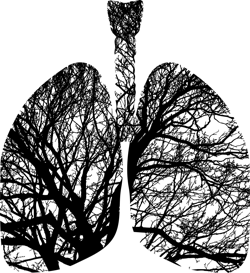Punctured lung affects nearly 1 percent of COVID-19 patients
As many as one in 100 patients admitted to hospital with COVID-19 develop a pneumothorax, or a punctured lung, according to a study led by researchers at the University of Cambridge.
Like the inner tube of bicycle or car tire, damage to the lungs can lead to a puncture. As air leaks out, it builds up in the cavity between the lung and chest wall, causing the lung to collapse. Known as a pneumothorax, this condition typically affects very tall young men or older patients with severe underlying lung disease.
During the pandemic, a team at the University of Cambridge and Addenbrooke's Hospital, part of Cambridge University NHS Foundation Trust, observed several patients with COVID-19 who had developed punctured lungs, even though they did not fall into either of these two categories.
"We started to see patients affected by a punctured lung, even among those who were not put on a ventilator," says Professor Stefan Marciniak from the Cambridge Institute of Medical Research. "To see if this was a real association, I put a call out to respiratory colleagues across the UK via Twitter. The response was dramatic - this was clearly something that others in the field were seeing."
Professor Marciniak subsequently obtained the appropriate ethical approvals and exchanged anonymized clinic information about 71 patients from around the UK. This led to a study published in European Respiratory Journal.
Although the team is unable to provide an accurate estimate of the incidence of punctured lung in COVID-19, admissions data from the 16 hospitals participating in the study revealed an incidence of 0.91 percent.
"Doctors need to be alert to the possibility of a punctured lung in patients with COVID-19, even in people who would not be thought to be typical at-risk patients," said Professor Marciniak, who is also a Fellow at St Catharine's College, Cambridge. "Many of the cases we reported were found incidentally - that is, their doctor had not suspected a punctured lung and the diagnosis was made by chance."
Just under two-thirds (63 percent) of patients with a punctured lung survived. Individuals younger than 70 years tended to survive, but older age was associated with a poor outcome - a 71 percent survival rate among patients younger than 70, compared with 42 percent among older patients.
Patients with a punctured lung were three times more likely to be male than female, although this may be accounted for by the fact that large studies of patients with COVID-19 suggest that men are more commonly affected by severe forms the disease. However, the survival rate did not differ between the sexes. Patients who had abnormally acidic blood, a condition known as acidosis that can result from poor lung function, also had poorer outcomes in COVID-19 pneumothorax.

